Nature Space Life Concept Art Nature Space Life Cosmos
Ask near any American whether life exists on other planets and moons, and the answer you'll go is a confident "yes!" Going back decades (and in many means generations), nosotros've been introduced to a menagerie of extraterrestrials good and bad. Their presence suffuses our amusement and culture, and we humans seem to have an almost innate belief-or is it a promise-that we are not solitary in the universe.
Just that extraterrestrial presence on regular display is, of course, a fiction. No life beyond Earth has ever been found; there is no evidence that alien life has always visited our planet. It's all a story.
This does non mean, nonetheless, that the universe is lifeless. While no articulate signs of life take always been detected, the possibility of extraterrestrial biological science – the scientific logic that supports information technology – has grown increasingly plausible. That is mayhap the single largest accomplishment of the burgeoning field of astrobiology, the broad-based study of the origins of life here and the search for life across World.
By exploring and illuminating the world of extreme life on Earth, by experimenting with how life here began, by agreement more than about the chemic makeup of the cosmos, past testing for habitability on missions to Mars, Saturn's moon Titan, and beyond, an enormous body of scientific discipline has already been assembled to analyze and explicate the origins, characteristics and possible extraterrestrial dimensions of life. And dissimilar the ETs and star-ship invaders of popular culture, these discoveries are real.

Artist's rendering of NASA'due south Cassini spacecraft observing a sunset through Titan'southward hazy atmosphere. Credit: NASA/JPL-Caltech
Turning Scientific discipline Fiction into Science Fact
Consider: The rover Curiosity has firmly adamant that ancient Mars was significantly more wet and warm, and was an entirely habitable place for microbial life. All the ingredients needed for life every bit we know it – the proper chemicals, a consistent source of free energy, and water that was likely present and stable on the surface for millions of years – were clearly present.
Did microbial life then begin? If and then, did it evolve? Those questions remain unanswered, simply this much is known: If a 2d genesis occurred on Mars (or on Jupiter's moon Europa, Saturn'due south moon Enceladus, or anywhere else in our solar system), then the likelihood increases substantially that many other forms of life exist on those billions of exoplanets and exomoons now known to orbit distant stars and planets. I origin of life on Earth could be the result of a remarkable and inexplicable pathway to life. Two origins in 1 solar system strongly suggests that life is commonplace in the universe.
Sounds of Space
Cassini's magnetometer detection of an atmosphere on Enceladus.
Consider, too, the revolution in understanding that has taken place since the mid-1990s regarding planets and moons in solar systems well beyond ours. Since aboriginal times, natural philosophers, then scientists, and untold interested others predicted, causeless even, that many other planets orbited their stars. Past now thousands of exoplanets have been officially identified – via NASA missions like Kepler likewise every bit basis-based observations — and billions more look discovery. And that's merely in our Milky Style milky way.
With advances in the instruments and knowledge that make possible the exoplanet chase, the focus has been increasing refined to identify planets lying in habitable zones – at distances from their stars that would allow water to remain at to the lowest degree periodically liquid on a planet's surface. The search for exoplanets was born in the fields of astronomy and astrophysics, just information technology has ever been intertwined with astrobiology as well. As with so many NASA missions, the broad and intense drive to find and sympathise habitable zone planets and moons both profoundly enhances astrobiology and is informed by astrobiology.
Our experience with finding distant planets also makes you wonder: Will the search for the current or past presence of extraterrestrial life some solar day be viewed as a parallel to the earlier search for exoplanets? Men and women of scientific discipline, too as the lay public, intuitively assumed planets existed beyond our solar organization, only these planets were identified just when our technology and thinking had sufficiently avant-garde. Is the discovery of ET life similarly awaiting our coming of scientific age?
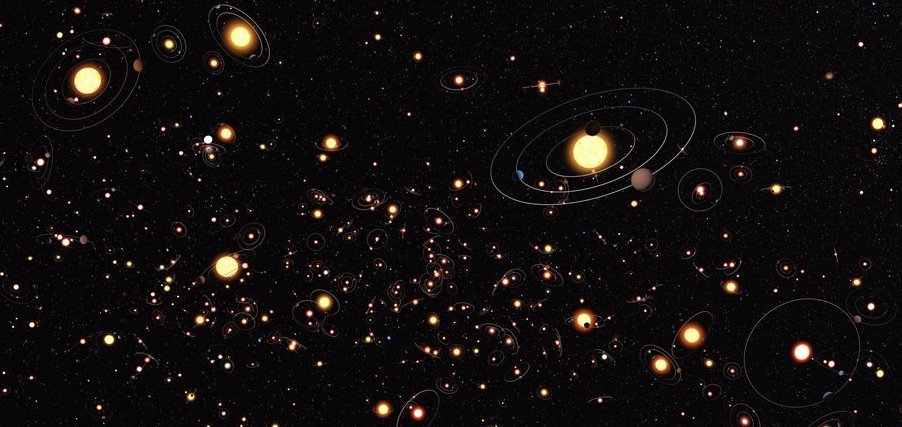
This is an creative rendering of planets orbiting stars in the Milky Mode (the planets, their orbits and their host stars are all vastly magnified compared to their real separations). After surveying millions of stars, we've ended that planets are the rule rather than the exception. Credit: ESO/M. Kornmesser
The Past Every bit a Guide to the Future
Astrobiology enquiry is taking place considering its time has come. Scientists across the state and effectually the world are diving into origin-of-life and life-beyond-Earth bug and developing exciting and cutting edge work. But NASA besides has an astrobiology "strategy" describing where the agency sees promising lines of enquiry – from the highly specific to the wide and wide — that the agency might support. A sampling of examples:
• What were the steps that led inanimate materials – rocks, sediments, organic compounds, water – to come up together and build living organisms, with replicating genes, cell walls, and the ability to reproduce?
• What led to the proliferation of new life forms on Earth?
• How practice water and essential organic compounds get in on planets and moons, and how do they interact with the planets and moons they country on?
• Is it possible to acquire from chemicals and minerals on the surface of planets whether microbes might live in that location, including beneath the planet's surface?
• Is it possible, likely even, that life exists elsewhere based on elements other than carbon and a system unlike than Deoxyribonucleic acid? Could such life even exist hither on World, but is as yet undetected?
Sounds of Space
The Huygens Probe Landing on Saturn'southward Moon Titan
These and and so many other lines of research shed light on how to identify and find extraterrestrial life, likewise as how to understand the origin of life on Earth. The two issues are inseparable.
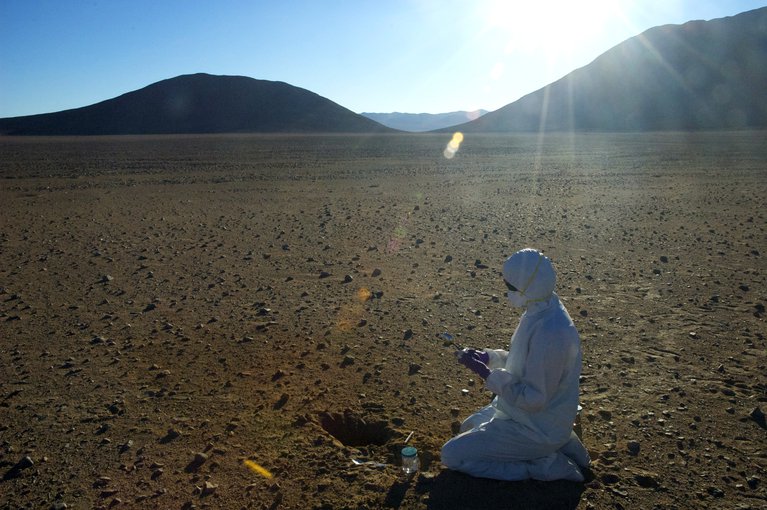
The Atacama desert is one of the driest places on World, making it a good Mars analogy. A scientist searching for signs of life ("biomarkers") in the soil must use make clean suits, gloves, masks, goggles, and sterile tools to make certain no contagion ends up in the sample. Prototype credit: Alfonso Davila/SETI Institute
The Earth of Astrobiology
While the United states of america and NASA have pioneered many lines of astrobiological report, we are hardly lonely – as is only proper for an effort to address such enormous and universal questions. Few astrobiology missions launch without significant international partnership, and the tendency is for ever greater interdependence.
Ane loftier-profile example is the ExoMars mission sponsored by the European Space Agency, with assistance from the Russian Infinite Bureau and NASA. A major goal of the mission is to test for the organic gas marsh gas in the martian atmosphere. While European scientists have made such global methane detections in recent years, it was the NASA detection of large plumes of released methane at specific sites that focused this ExoMars mission goal. Astrobiology cooperation is oftentimes intellectual as well every bit operational.
Astrobiology may sometimes seem well-nigh defined by high-contour missions, merely ofttimes those missions represent years of prior theoretical and laboratory piece of work. And once data from missions have been obtained, more lab assay and testing has to take place, and then exist challenged and criticized by colleagues, before the results can exist released equally a significant finding. For case, it took almost ii years of intensive lab work and data analysis before members of the Curiosity science team could announce that they had teased out from Mars drill samples the presence of long-sought organic compounds, the building blocks of life as nosotros know it.
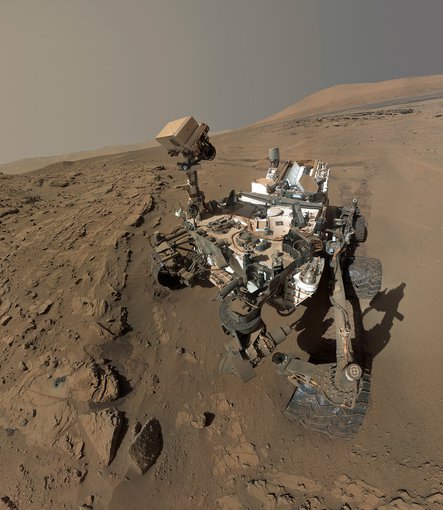
Mars Marvel rover'due south one-year ceremony selfie. The photo was actually composed of dozens of individual images taken between Apr and May 2014. Marvel's mission is to observe evidence of past or present habitable conditions on the surface of Mars. Credit: NASA
Looking for Life
At the heart of astrobiology is yet another basic and unanswered question: What actually is life? One might think after centuries of study that upshot would be resolved, for life on Earth at least. Really, it's getting increasingly complicated to come upwards with an answer that takes in all the "lifeforms" discovered and that might have in one case existed on our planet. One frequently used definition of life is "a self-sustaining system capable of Darwinian evolution." But at that place are literally several hundred more than.
Ironically, some astrobiologists fence that we really won't know what life is until we detect an alternative to the basic structure found on World – the same Dna, metabolism and carbon-based pattern shared past all known life. In other words, ET life could tell us what life really is.
A corollary to this line of thinking is the ever-present concern that a rover or lander has, or will, come across an example or signature of life present or past, and not know it. This reality helps explain the emphasis that astrobiology puts on understanding the origins and logic of early life on Globe. In addition to its inherent importance, origin-of-life research guides the search for extraterrestrial life.
That NASA is very much in the business organization of the search for life beyond Earth is by now well known to the public, while the agency'southward mission to make progress in agreement the origins of life on Earth is less well understood. Some, still, no dubiety wonder why NASA investigates biological questions at all. Isn't the chief focus of the bureau to use robots and astronauts in infinite capsules to travel in space and explore?
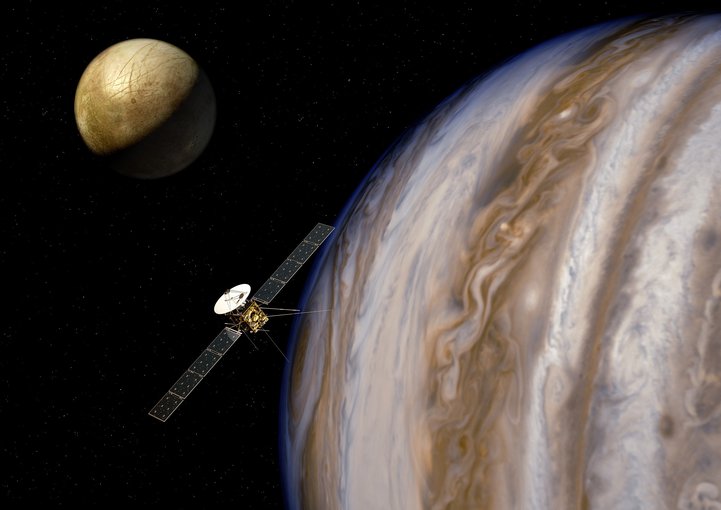
Artist'due south impression of the Jupiter Icy Moons Explorer (JUICE) near Jupiter and i of its moons, Europa. Credit: ESA/AOES
Really, today's NASA has a much broader portfolio, one that includes the study of subjects ranging from the early universe and the formation of galaxies, stars and solar systems, to measuring the Earth's atmosphere and meliorate understanding its changing climate. And with ever greater sophistication, astrobiology is an essential part of NASA as well.
The search for life beyond Globe is so intertwined with other NASA goals (and is so interdisciplinary past nature and design), it can never really be separated or isolated from them. The Cassini mission to Saturn discovered plumes spitting out of the moon Enceladus, and the Hubble Space Telescope did the same for Europa. Both plumes tell of an inner water earth, and then are important to planetary science besides as astrobiology. The Kepler mission has identified thousands of exoplanets in a pocket-sized segment of the constellation Cygnus, 500 light years away, adding enormously to our understanding of the inventory and nature of distant planets. Included in those discoveries are the detection of rocky planets inside the habitable zones of their central stars.
The central goal of astrobiology is to find evidence of past or present life beyond Earth, if information technology ever existed. Merely in that location are endless mysteries well-nigh planets and moons, about solar systems, nearly galaxies and well-nigh the makeup of the infinite between them that inevitably will be confronted and unraveled along the fashion. Ultimately, the search for extraterrestrial life is possible just as part of an exploration of the makeup, the dynamics, the history and the many as yet unknown wonders of the cosmos.
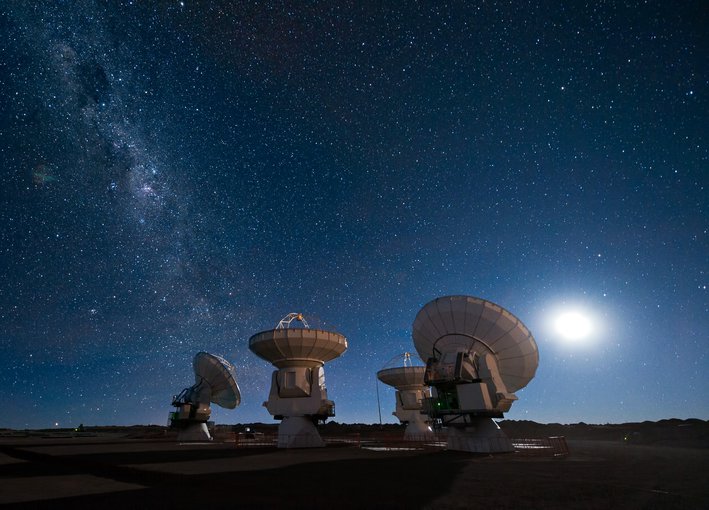
4 antennas of the Atacama Big Millimeter/submillimeter Array (ALMA) gaze up at the stars and the band of the Milky Mode. Astronomers can apply such telescopes to study star formation, equally well as the origins of galaxies and planets. Credit: ESO/José Francisco Salgado
Written by Marc Kaufman

Marc Kaufman is an experienced announcer, having spent three decades at the Washington Post and the Philadelphia Inquirer, and is the author of two books on searching for life and planetary habitability. He also writes the Many Worlds blog.
Source: https://astrobiology.nasa.gov/about/
0 Response to "Nature Space Life Concept Art Nature Space Life Cosmos"
Post a Comment